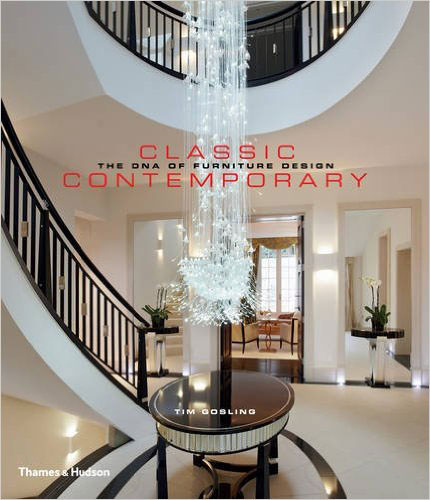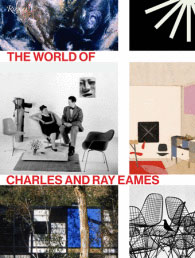This month’s Design Book List is filled with books on architecture, furniture and landscape design. Gain inspiration and learn from February’s new and upcoming design book releases.
Included in this month’s Design Book List are: “Concrete Concept: Brutalist Buildings Around the World,” “William Krisel’s Palm Springs: The Language of Modernism,” “Classic Contemporary: The DNA of Furniture Design,” “The World of Charles and Ray Eames,” “Landscape as Urbanism: A General Theory,” “Glass / Wood: Erieta Attali on Kengo Kuma” and “Architecture of Life.”
“Concrete Concept: Brutalist Buildings Around the World”

“Concrete Concept” takes architecture admirers on a tour of the world's most celebrated and controversial Brutalist buildings. Featuring 50 international examples (built between the 1950s to 1970s), it skips from one country to the next to illustrate why utilitarian concrete buildings grew to become both the most hotly contested and fashionable architectural style in history. Descriptions cover key details about the building as well as a context for its original use, public reception and current status.
BASIC FACTS: “Concrete Concept: Brutalist Buildings Around the World” is written by Christopher Beanland. Published by Frances Lincoln. Release Date: February 4, 2016. Hardcover; 192 pages; $30.00.
“William Krisel’s Palm Springs: The Language of Modernism”

This first major monograph chronicling the work and architectural philosophy of William Krisel features examples and insights from Krisel's own papers, culled from his personal collection as well as the archives of the Getty Research Institute. Krisel's architectural drawings and renderings, and archival photographs, highlight examples of his custom homes, mass-produced housing, and recreational facilities in Palm Springs and in the rest of the Coachella Valley.
About the Authors: Heidi Creighton is a midcentury modern enthusiast, writer, collector, and researcher. In 2012, she purchased a Palm Springs home designed by William Krisel in 1957. Chris Menrad, is a founding board member of the Palm Springs Modern Committee, an organization dedicated to the preservation of Desert Modern architecture and a real estate agent specializing in architectural properties in the Coachella Valley. He lives in a Krisel designed home, which was the first Palm Springs' Class One historic Krisel/Alexander built house.
BASIC FACTS: “William Krisel’s Palm Springs: The Language of Modernism” is written by Heidi Creighton and Chris Menrad. Published by Gibbs Smith. Release Date: February 9, 2016. Hardcover; 224 pages; $45.00.
“Classic Contemporary: The DNA of Furniture Design”

A furniture designer’s in-depth look at the creations―both classic and contemporary―that have inspired him. Tim Gosling is internationally renowned for his designed interiors and crafted furniture catering to a range of public and private clients. Whether a Georgian town house or Victorian mansion, a Venetian penthouse or Florida home, Gosling brings both a classic and a contemporary look to his work that respects the architecture of the space and the needs of those who commission him.
“Classic Contemporary” is an opportunity for Gosling to explore his influences, including historical sources (dating from the eighteenth century to the twentieth) and the work of contemporaries. He examines the most essential elements, not just the bones but also the DNA of classic design, to discover how they have endured and how they can be adapted for contemporary tastes. Through these pages, Regency, Victorian, Art Deco, or Modernism can be viewed in a new light, providing inspiration and insight into the work of this designer.
BASIC FACTS: “Classic Contemporary: The DNA of Furniture Design” is written by Tim Gosling. Published by Thames & Hudson. Release Date: February 15, 2016. Hardcover; 240 pages; $75.00.
“The World of Charles and Ray Eames”

This is the first comprehensive book on the Eames' legacy in over a decade, revealing the rich totality of their work in all mediums. Produced in close collaboration with the Eames estate, this book publication presents the husband-and-wife team from both personal and professional perspectives, as well as the lively interplay of their public and private lives. Charles and Ray Eames are among the most important twentieth century designers, and the story of the Eames Office is that of the history of visual and material culture in the post-war, modern period.
Published in connection to a major exhibition developed in partnership with the Eames Estate opening at London's Barbican Art Gallery in October 2015, the book features a broad range of visual material. It explores the era-defining work of the Eames Office, a 'laboratory' active for over four decades that produced a vast array of pioneering and influential projects― from architecture, furniture and product design to film, photography, multi-media installation and exhibitions, as well as new models for arts education. Alongside newly commissioned texts by leading design experts, “The World of Charles and Ray Eames” will include contemporaneous reviews and magazine articles, writings by Charles and Ray Eames themselves, personal correspondence and a comprehensive reference section.
BASIC FACTS: “The World of Charles and Ray Eames” is written by Catherine Ince (Editor). Published by Rizzoli. Release Date: February 16, 2016. Hardcover; 320 pages; $75.00.
“Landscape as Urbanism: A General Theory”

It has become conventional to think of urbanism and landscape as opposing one another― or to think of landscape as merely providing temporary relief from urban life as shaped by buildings and infrastructure. But, driven in part by environmental concerns, landscape has recently emerged as a model and medium for the city, with some theorists arguing that landscape architects are the urbanists of our age. In “Landscape as Urbanism,” one of the field's pioneers presents a powerful case for rethinking the city through landscape.
Charles Waldheim traces the roots of landscape as a form of urbanism from its origins in the Renaissance through the twentieth century. The concept was further informed by the nineteenth-century invention of landscape architecture as a "new art" charged with reconciling the design of the industrial city with its ecological and social conditions. In the late twentieth and early twenty-first centuries, as urban planning shifted from design to social science, and as urban design committed to neo-traditional models of town planning, landscape urbanism emerged to fill a void at the heart of the contemporary urban project. Generously illustrated, “Landscape as Urbanism” examines works from around the world by designers ranging from Ludwig Hilberseimer, Andrea Branzi, and Frank Lloyd Wright to James Corner, Adriaan Geuze, and Michael Van Valkenburgh.
BASIC FACTS: “Landscape as Urbanism: A General Theory” is written by Charles Waldheim. Published by Princeton University Press. Release Date: February 16, 2016. Hardcover; 216 pages; $45.00.
“Glass / Wood: Erieta Attali on Kengo Kuma”

The acclaimed Japanese architect Kengo Kuma (born 1954) and photographer Erieta Attali complement one another perfectly in terms of their artistic statement: both of them focus on the inclusion of the landscape. It is not the architecture as such that plays the primary role but the way in which it communicates with the surrounding world. Details from nature and the intricate connection of interior with exterior space characterize the photographs by Attali.
In his unique works, Kuma combines Japanese traditions in architecture with those of modernist architecture. His architecture constitutes a bridge where the individual and nature meet. Kuma became famous in the West for his sensitive extension to a mid-century icon in New Canaan, Connecticut, which this monograph portrays.
BASIC FACTS: “Glass / Wood: Erieta Attali on Kengo Kuma” is written by Erieta Attali (Photographer) and Kengo Kuma (Artist). Published by Hatje Cantz. Release Date: February 23, 2016. Hardcover; 120 pages; $75.00.
“Architecture of Life”

Published in conjunction with BAMPFA's inaugural exhibition in its new building designed by Diller Scofidio + Renfro, “Architecture of Life” explores the ways that architecture-as concept, metaphor and practice-illuminates various aspects of life experience.
It comprises over 275 works of art, scientific illustrations and architectural drawings and models, and includes work by Wilson Bentley, Lee Bontecou, Louise Bourgeois, Diller Scofidio + Renfro, Marcel Duchamp, Suzan Frecon, Buckminster Fuller, Johannes Itten, Tomás Saraceno, Viktor Schauberger, Lebbeus Woods and Iannis Xenakis, as well as Mbuti drawings, Pomo baskets, Micronesian navigational charts, Tibetan mandalas and tantric drawings from Rajasthan.
BASIC FACTS: “Architecture of Life” is written by Sabrina Valle, Padma Maitland and Lawrence Rinder. Published by University of California, Berkeley Art Museum and Pacific Film Archive. Release Date: February 23, 2016. Paperback; 362 pages; $39.95.
_________________________________
Copyright 2016 Hamptons Art Hub LLC. All rights reserved.
